The holy grail of crypto is mass adoption: a future in which people across the world use digital currencies to pay for goods and services on a daily basis. However, there’s a lot that needs to change before we see people regularly paying for their morning coffee with XRP or using ETH to buy their weekly grocery shopping.
If we all simply sit around and hodl our crypto then mass adoption is never going to happen. We need to spend it – and be able to spend it – if we want to see it mount a meaningful challenge to the fiat status quo.
The emergence of crypto debit cards is starting to play a key role in this respect, enabling users to spend their crypto easily and safely. Many also offer some enticing perks and incentives, making them an attractive alternative to the old guard of fiat debit cards used across the world.
More crypto debit cards are appearing all the time and it can be difficult to choose which one may be right for you. Each has its own benefits and rewards and some will only be suitable for those living in certain countries or regions. There’s a lot to consider when deciding which card to go for.
So, to help you make that decision and start putting your crypto to work, we at Coin Bureau have drawn up a list of the seven best ones out there right now.
1. Crypto.com
There’s a card to suit every lifestyle at Crypto.com, from those who treat themself to an iced latte every so often, right through to the type who has their chauffeur pull over outside Van Cleef and Arpels.
Most Crypto.com cards require you to stake a certain amount of their native MCO token to qualify and if you want the top-tier Obsidian card, then you’ll have to front up 50,000 MCO ($206,000 at the time of writing).
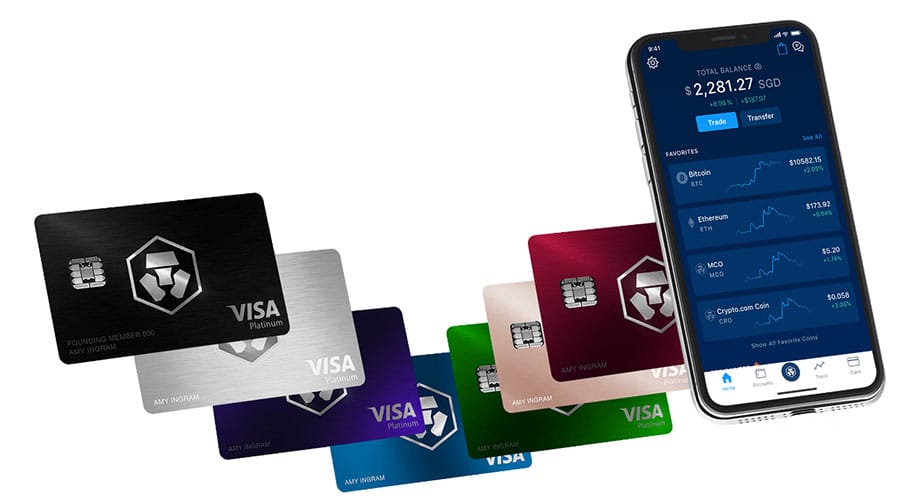
Collection of Crypto.com Cards and Mobile App
Happily, there are cheaper options available and these still offer some great value. It’s worth noting that the staked MCO tokens are refundable – you can get them back if you decide to leave. All rewards are also paid in MCO tokens that have widespread exchange support.
The two cards we’ve picked out are the entry-level Midnight Blue card and the Ruby Steel. The Blue card doesn’t require you to stake any MCO and offers 1% MCO rewards on all spending.
The card offers a monthly interbank exchange rate up to $2,000 and you can withdraw up to $200 a month from ATMs for free, though there’s a 2% fee thereafter. The Blue card is a great option if you want to get a crypto debit card with no commitment and a decent return on your everyday spending.
The Ruby card is the next step up and comes with 2% rewards and a free Spotify subscription worth $12.99 a month. This works out as a saving of $155.88 a year, which helps offset most of the $206 you’ll need to stake in MCO to qualify for the card.
Add the 2% cashback on spending and you can earn a healthy return from the Ruby card without having to spend big. ATM withdrawals and interbank limits are double those of the Blue card ($400 and $4,000 respectively). The card itself is also made of metal, which could prove useful if you ever find yourself in a Patrick Bateman-style face-off.
It’s well worth checking out the other tiers of card available on Crypto.com and the rewards they offer. If you’re happy to stake larger amounts of MCO (which you can get back, remember) then there are loads of other rewards and higher levels of cashback available.
2. Nexo
If you want to leverage the value of your crypto portfolio without actually having to spend those coins you’ve spent so long acquiring, then Nexo could be just what you’re looking for. This card will give you credit in over 45 fiat currencies, based on the value of your crypto holdings. There’s an impressive list of supported coins here too, so most portfolios should have access to credit.
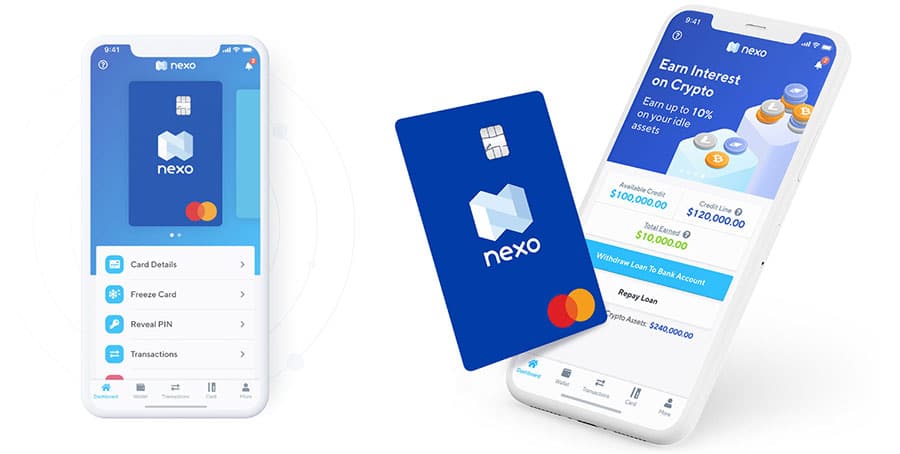
Nexo Debit Card
The card itself is backed by MasterCard, so using it almost anywhere shouldn’t be a problem. There’s instant cashback on all purchases and you can make payments in local currencies, avoiding those pesky foreign exchange fees. There are also no monthly or annual exchange fees to worry about, though there’s a base-rate APR of 5.9% on all purchases.
The cashback rate is a decent 2% and can be paid in either the native NEXO token or in BTC. Getting your hands on a card is easy, as there are no credit checks or long application processes. Nexo itself is a subsidiary of Credissimo, so it has backing from an established fintech player.
3. Monolith
Let’s face it, those card fees are a pain and it’s easy to feel like card providers are squeezing you at every opportunity. If those fees get you down, then the Monolith card may be the one for you.
Yes, there are still fees to pay, but these are much more reasonable than most other cards, especially when spending at home. You don’t pay any purchase fees if you’re spending in your native currency and there’s no top-up fee if you top the card up with DAI stablecoin.
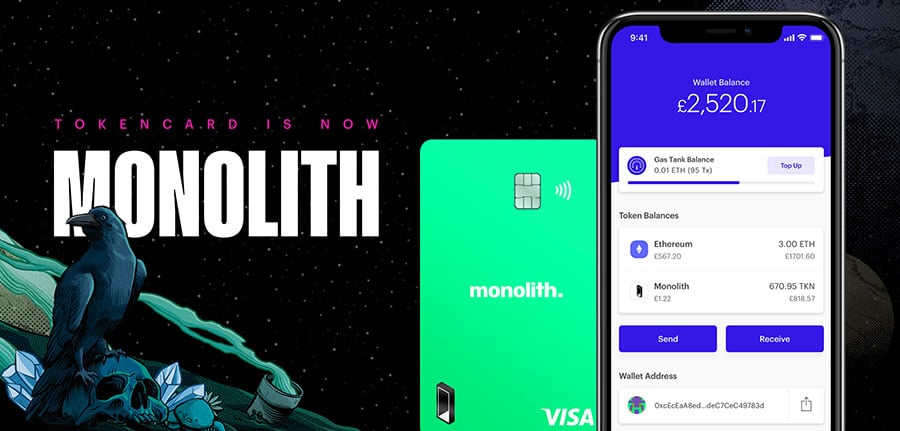
Monolith Debit Card
Monolith is a DeFi platform built on Ethereum, so the card itself supports all ERC-20 tokens. You load the card with any ERC-20 token of your choice and can then spend the funds through its Visa-backed fiat gateway.
This means it’s accepted almost anywhere, allowing you to spend your crypto wherever you please. The accompanying app helps you track your spending and the Monolith non-custodial wallet is open-source: great news for those who want to assure themselves that everything is above board.
If the Monolith card has a drawback, it’s that it is not currently available to US customers. Then there’s also the fact that it’s Ethereum only, which means a lot of tokens (Bitcoin most notably) can’t be used with it. But these are minor concerns and, with those competitive fees and the backing of an exciting DeFi enterprise, this is a card that should be on your radar.
4. BlockCard
Finally something to put a smile on the face of those Americans wanting to join the crypto card party.
Ternio’s BlockCard is essentially a Visa debit card, which is preloaded with crypto in much the same way as most of the other cards on this list. It supports a good – and growing – list of coins and its fees are pretty decent too, with no deposit exchange or withdrawal charges.
There’s a monthly $5 subscription fee, but this is waived if you spend over $750 a month at POS merchants. There’s a full list of fees here, but the takeout is that they compare favourably with most other cards.

Blockcard Card & Mobile App
It’s rare to find a crypto card that works with Apple and Google Pay, so this integration is a big plus for BlockCard and should make life that little bit easier for users. You’ll need to complete KYC procedures in order to get your card and there are rewards available too, although you’ll need to stake TERN in order to qualify.
The top rate is a whopping 6.38% and for that you’ll need to stake 145,000 TERN (around $1,037 at current prices). This is one of the best staking returns out there, so well worth investigating.
If you’re in the US then BlockCard should be your first port of call when seeking out a crypto card.
5. Wirex
Here’s another Visa-backed card that you preload with your crypto. It supports a decent list of coins and fiat currencies, though sadly it is only available to customers in Europe and Singapore.
The card fees are pretty good too: nothing upfront and a £1.75/€2.25 ATM fee, though there is a £1.00/€1.20 monthly card maintenance charge. Depositing funds in fiat is free if you use SEPA in Europe or faster payments in the UK. If you deposit in crypto then there’s a 1% fee – not ideal but offset by the fact that there are no in-store or online fees to worry about.
Wirex also offers a decent crypto cashback return of 1.5% on all purchases, though there’s a caveat here. The base cashback rate is 0.5% and if you want to increase it then you’ll have to stake some of the native WXT token in order to qualify.
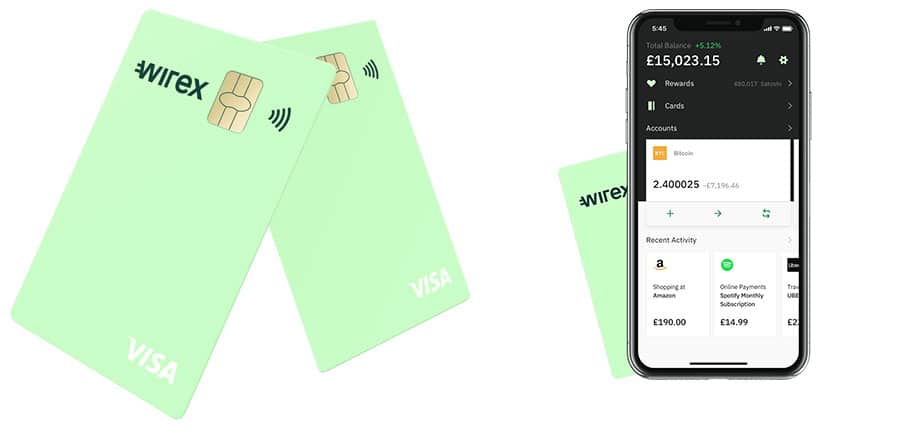
Wirex Visa card and Mobile Application
To get 0.75% you’ll need to stake around $500 worth of WXT; for 1% that rises to £1,000 and for the 1.5% rate you’ll need to hold WXT worth $5,000. That’s a lot of money to front up for that cashback rate, though of course that is a stake you can get back if you cancel the card.
Having said that, if you’re able to stake this sort of money then chances are you’ve got a fair amount of the stuff kicking about. If that’s the case then Wirex’s transaction limits may seal the deal for you.
The daily spend limit in Europe and Singapore is $10,000 and the daily SEPA withdrawals and deposits are capped at $500,000. You’ll need to be living pretty hard to fall foul of these. In the UK the transaction limit is much less at a mere £3,000 per day, so that blowout in Selfridges might need to be kept a little low-key.
If you’ve got the money to spend then the Wirex card is a good option. For the majority of us mortals however, there are better options out there.
6. BitPay
Here’s another option for those of you in the US – and soon for Europeans as well.
The BitPay card is backed by Visa and, as above, you preload with your crypto and get spending. As with Wirex, the limits allow you to live the high life, should you so wish. You can hold a maximum balance of $25,000; the daily spend limit is $10,000 and if you like to make it rain then you can withdraw up to $3,000 per day.
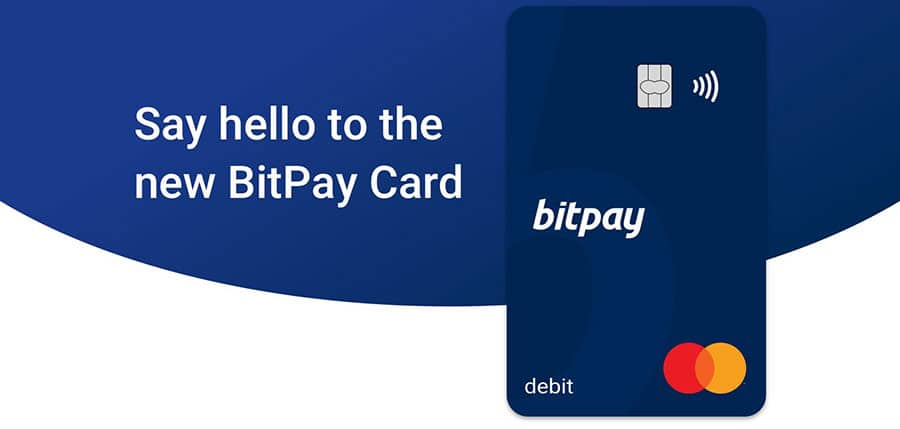
The Launch of the Bitpay Debit Card
ATM withdrawals cost $2 in the US and $3 abroad and if you spend outside of the US then there’s a 3% fee for every transaction. Just be sure to keep spending regularly though: there’s an inactivity fee of $5 per month if you don’t use the card for 90 days.
These fees aren’t too bad and the spending limits should allow you to have a good time, unless your tastes have gotten out of hand. However, BitPay is lacking in other areas. It supports a fairly limited range of coins and there’s currently nothing doing in terms of rewards or cashback offers.
The BitPay card falls a long way short of most of the other cards here, but it does at least offer some extra choice for those of you in the US.
7. Coinbase Card
Ah, Coinbase: a name familiar to almost anyone with even a passing interest in crypto. It’s been the starting point for so many on their journey through the cryptoverse and it’s hardly surprising to see that they too offer a crypto card.
The Coinbase card supports nine different cryptos and is available pretty much anywhere in Europe. They are ‘working on expanding the offer to additional markets,’ so if you don’t live in Europe then you’ll just have to wait or go for another option.
However, it’s the fees that let this card down. The good people at Coinbase seem to have gone for the option of squeezing a fee out of their users wherever they can. If you withdraw more than £200/€200 a month from an ATM then you’ll be charged 1% on that excess. Use it abroad and it’s 2%. Foreign exchange fees are 3% and then there’s a crypto liquidation fee of 2.49% just to put the icing on the cake.
The daily spend limit is £10,000/€10,000, though these can be changed if desired and the daily ATM withdrawal limit is £500/€500. Domestic purchases don’t incur a fee, which is something. The GBP/EUR parity is rather strange but it does at least keep things simple.
Although Coinbase is a big player in crypto and has the sort of top security you’d expect, the fact remains that using the card is going to cost you a lot more than many of the others we’ve covered here.
Conclusion
And there we have it, the Coin Bureau’s top seven crypto cards. There are many different factors to bear in mind when choosing yours and we hope this handy guide has made that choice a little easier.
Spend those coins wisely (unless you’re an Obsidian card holder, in which please feel free to go bananas) and remember that every time you flex that plastic, you’re driving us that closer towards mass adoption. Bottoms up.
Featured Image via Shutterstock
Source: https://www.coinbureau.com/analysis/best-crypto-debit-cards/
- &
- 000
- 7
- access
- Additional
- Adoption
- All
- Allowing
- app
- Apple
- Application
- around
- ATM
- BEST
- Bit
- Bitcoin
- BitPay
- board
- BTC
- buy
- call
- challenge
- chances
- change
- charge
- charged
- charges
- checking
- Checks
- closer
- Coffee
- Coin
- coinbase
- CoinBureau
- Coins
- countries
- credit
- crypto
- Crypto.com
- currencies
- Currency
- Current
- Customers
- data
- day
- deal
- Debit Card
- Debit Cards
- DeFi
- digital
- digital currencies
- driving
- Enterprise
- ERC-20
- ethereum
- Europe
- Europeans
- exchange
- expanding
- Face
- fair
- Features
- Fees
- Fiat
- fintech
- First
- foreign exchange
- Free
- full
- funds
- future
- good
- goods
- Google Pay
- Grail
- great
- grocery
- Growing
- guide
- handy
- here
- High
- HODL
- hold
- Home
- HTTPS
- image
- Increase
- integration
- interest
- IT
- join
- Key
- KYC
- launch
- Leverage
- lifestyle
- Liquidation
- List
- load
- local
- Long
- Majority
- Making
- Markets
- mastercard
- Merchants
- metal
- Mobile
- Mobile app
- money
- news
- nexo
- offer
- Offers
- offset
- online
- Opportunity
- Option
- Options
- order
- Other
- Others
- Pain
- Pay
- payments
- People
- plastic
- platform
- player
- portfolio
- PoS
- purchase
- purchases
- radar
- returns
- Rewards
- saving
- security
- Services
- Shopping
- Short
- Simple
- Singapore
- So
- spend
- Spending
- Spotify
- stake
- Staked
- Staking
- start
- Status
- steel
- subscription
- subsidiary
- support
- Supported
- Supports
- time
- token
- Tokens
- top
- track
- transaction
- treat
- Uk
- us
- users
- value
- visa
- W3
- wait
- Wallet
- weekly
- WHO
- Wirex
- Work
- works
- world
- worth
- writing
- year
- youtube













